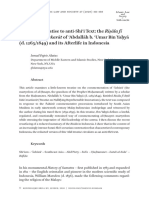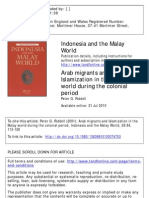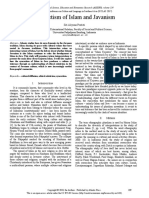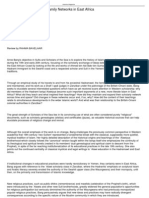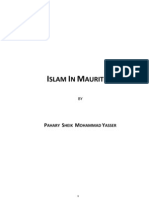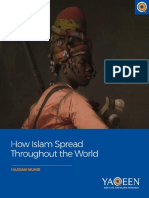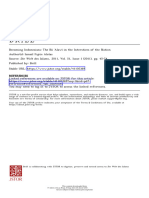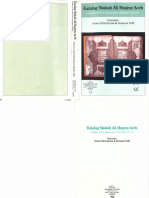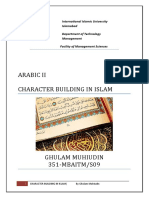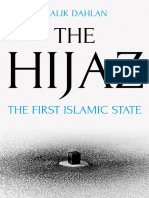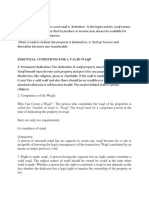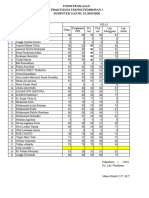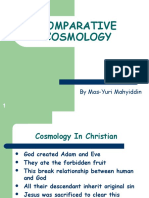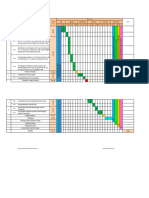2007 - (Ismail Fajrie Alatas) The Upsurge of Memory in The Case of Haul A Problem of Islamic Historiography in Indonesia
2007 - (Ismail Fajrie Alatas) The Upsurge of Memory in The Case of Haul A Problem of Islamic Historiography in Indonesia
Uploaded by
Egi Tanadi TaufikCopyright:
Available Formats
2007 - (Ismail Fajrie Alatas) The Upsurge of Memory in The Case of Haul A Problem of Islamic Historiography in Indonesia
2007 - (Ismail Fajrie Alatas) The Upsurge of Memory in The Case of Haul A Problem of Islamic Historiography in Indonesia
Uploaded by
Egi Tanadi TaufikOriginal Title
Copyright
Available Formats
Share this document
Did you find this document useful?
Is this content inappropriate?
Copyright:
Available Formats
2007 - (Ismail Fajrie Alatas) The Upsurge of Memory in The Case of Haul A Problem of Islamic Historiography in Indonesia
2007 - (Ismail Fajrie Alatas) The Upsurge of Memory in The Case of Haul A Problem of Islamic Historiography in Indonesia
Uploaded by
Egi Tanadi TaufikCopyright:
Available Formats
The Upsurge of Memory in The Case of Haul
THE UPSURGE OF MEMORY IN THE CASE OF HAUL:
A Problem of Islamic Historiography in Indonesia
Ismail F. Alatas
The National University of Singapore
Abstract: This essay investigates the reasons behind the
proliferation of haul celebrations in Indonesia. The study
focuses on the construction of haul as a ritual forging
collective memory among a particular group of people in
the Muslim community. The writer adopts Pierre Nora’s
theory of the upsurge of memory which is caused by the
acceleration and democratization of history. These two
factors bring about the construction of an object which
forms the passage of memory among those attending haul.
It will be argued that the haul is a social construction by a
noble community to demonstrate its existence and
domination over others in the Muslim community. It will
also be argued that the haul was a reaction towards
modernity in the Muslim world and the rise of alternative
historiography. The influential position of the aristocracy
was based on the construction of collective memory of the
people in haul celebrations, which are held all over
Indonesia.
Keywords: Haul, Sa>dah, memory, historiography.
Introduction
The tradition of haul1 has been a fascinating phenomenon in
Indonesia. Today, there are over fifty haul celebrations scattered
throughout the Archipelago. There is little attention, however, paid to
the study of the emergence of this religious festivity. This essay will
look into the reasons behind the proliferation of this celebration,
which began in the early Twentieth Century. In approaching the
1 Haul linguistically means circuit. This term, however, is used to describe the annual
pilgrimage to the shrine of a deceased saint.
JOURNAL OF INDONESIAN ISLAM 267
Volume 01, Number 02, December 2007 267
Ismail F. Alatas
subject matter, it will adopt Pierre Nora’s theory on the upsurge of
memory.2 Nora believes that the upsurge of memory is caused by the
acceleration and democratization of history.3 These two factors result
in the construction of an object, which becomes the passage of
memory. The study focuses on the construction of haul as a ritual,
which forges collective memory about particular group of people. It
will be argued that this construction was the result of the adoption of
modernity in the Muslim world and the rise of alternative
historiography. Therefore, from this point of view, haul can be seen as
a reaction against the tide of modernity.
The haul ritual in Indonesia originated from the province of
Hadramaut in the modern Yemen. In this region, society was stratified
according to their ancestral background. At the top were the Sa>dah
(sing. Sayyid) or the descendants of Prophet Muh}ammad, followed by
the Masha>yi>kh who were the descendants of well-known religious
scholars and the Qaba>’il who were tribesmen and finally the Masa>ki>n or
those who were economically deprived without either religious or
tribal affiliation.4 The Sa>dah and the Masha>yi>kh restricted other social
groups to have access to scholarship while the rest of the population
struggled for their economic necessities. The position of the Sa>dah
became vital because they were seen as the people with soul in a
“soulless place.” Their piety and intellectualism became a model for
others. Linda Boxberger states that “the ritual life of the community
focused around a spiritual leader and often around the memory of a
previous spiritual leader.”5 The Sa>dah, therefore, became a medium for
intercessions, thereby establishing a cult of saints in Hadramaut. The
proliferation of domed shrines throughout the valley became the
material symbol of the Sa>dah’s religious authority.
Once a year a haul was held in each shrine where all tribes and
scholars gathered together to honor a particular deceased saint. The
2 Pierre Nora, "Between Memory and History: Les lieux de memoire," Representation, 26
(1989).
3 Ibid.
4 Sylvaine Cameline, "Reflections on the System of Social Stratification in
Hadramaut,",in Ulrike Freitag and William G. Clarence-Smith (eds), Hadrami Traders,
Scholars and Statesmen in the Indian Ocean, 1750s-1960s (New York: Brill, 1997), p. 148
5 Linda Boxberger, On the Edge of Empire:Hadramawt, Emigration and the Indian Ocean,
1880s-1930s (Albany: State University of New York Press, 2002), p. 153.
268 JOURNAL OF INDONESIAN ISLAM
Volume 01, Number 02, December 2007
The Upsurge of Memory in The Case of Haul
haul was led by the successor of the Sa>dah and throughout the ritual
there were a number of orations intended to recall the memory of the
pious ancestors of the Sa>dah. In doing so, it stressed the continuous
function of the Sa>dah and affirmed the authority of their descendants,
who claimed to have acquired al-sult}a>t al-ru>h}i>yah (spiritual powers),
derived from their ancestors.6 Paramount also to the consolidation of
the collective memory of the pilgrims were the hagiographies of the
Sa>dah, which praised the noble ancestry of this particular group.7 The
hagiographies together with poems praising the Sa>dah were read during
the haul. Therefore, the authority of the Sa>dah was derived from the
memory of the past ancestral saints, which was collectivized in the haul
ritual.
During the 19th century, emigration from Hadramaut to Southeast
Asia reached its peak. The growth of capitalism in what were the
Dutch East Indies and British Malaya attracted the Hadramis who
were struggling for their economic conditions to come and participate.
This rapid economic development in Southeast Asia came as a result
of the opening of the Suez Canal in 1869.8 Hadramis from different
social backgrounds took part in this mercantile project in Southeast
Asia. In Indonesia, many Sa>dah succeeded in the trade and enjoyed the
respect and admiration of the indigenous people because of their
blood relation to the Prophet. Despite the geographical distance
between Indonesia and Hadramaut, the connection remained strong.9
This is because Hadramaut was regarded as the spiritual center of the
Hadramis in Indonesia, bound by the cult of saints that was
symbolized by the shrines of the Sa>dah’s ancestral lines. Hence, the
status quo, which assured Sa>dah’s hegemony, was maintained in
Indonesia during the 19th century.
6 Abdalla S. Bujra, The Politics of Stratification: A Study of Political Change in a South Arabian
Town (Oxford: Clarendon Press, 1971), p. 28.
7Alexander Knysh, "The Cult of Saints and Islamic Reformism in Early Twentieth
Century Hadramawt," New Arabian Studies, 4, (1997), p. 145.
8Engseng Ho, "Hadramis Abroad in Hadramaut: The Muwalladin," in Freitag and
Clarence-Smith (eds), Hadrami Traders, Scholars and Statesmen, p. 139.
9 Ulrike Freitag, "Hadramaut: a Religious Center for the Indian Ocean in the Late 19th
and Early 20th Centuries?" Studia Islamica (1999), p. 182.
JOURNAL OF INDONESIAN ISLAM 269
Volume 01, Number 02, December 2007 269
Ismail F. Alatas
The Acceleration of History:
Pan-Islamism and The High Reforms
The challenge faced by the Sa>dah in Indonesia was inextricably
linked to the tide of modernity. Rapid European progression, which
was preceded by the advance of modernity, generated fear amongst
Muslims in the Middle East. The reaction to this tremendous progress
was the founding of the pan-Islamic movement by the Ottoman caliph
Abdul Hamid II.10 This movement was intended to secure loyalties of
the Muslims to the Ottoman caliphate amidst the rapid European
penetration into the Muslim world. Furthermore, European
domination resulted in the rise of modern Islamic movement, such as
one that was devised by Jamaluddin al-Afghani. Afghani published a
journal entitled al-‘Urwah al-Wuthqa>, by which he could spread his call
for struggle against the hegemony of colonialism over the Muslim
lands.11 His disciple, Muhammad Abduh, continued his work by
decreeing the reform of Islam. Abduh believed that Muslims should
adopt modernity in order to develop the Muslim community.12
The ascension of Islamic modernism in the Middle East
additionally affected the Hadramis in Indonesia. There were several
factors that contributed to this. First was the dissatisfaction amongst
the Hadramis in general with the Dutch authority as a result of an
economic predicament in Indonesia.13 Secondly was the rise of Japan,
which was the only newly modern Eastern contender that could
compete with the Europeans.14 Japan became the inspiration for the
non-Europeans to follow in order to develop their community. Thirdly
was the awakening of the Indonesian Chinese population, who
organized the first non-European modern organization, the Tiong Hoa
William L. Cleveland, A History of the Modern Middle East, Second Edition (Boulder:
10
Westview Press: 2000), p. 118.
11 Ibid, p. 123.
12 Ibid, p. 124.
13Sumit K. Mandal, "Natural Leaders of Native Muslims: Arab Ethnicity and Politics
in Java Under Dutch Rule," in Freitag and Clarence-Smith (eds), Hadrami Traders,
Scholars and Statesmen, p. 187.
14 Ibid, p.187.
270 JOURNAL OF INDONESIAN ISLAM
Volume 01, Number 02, December 2007
The Upsurge of Memory in The Case of Haul
Hwe Koan.15 And lastly was the availability of the reformist publication,
notably the Egyptian journal al-Mana>r in Indonesia.16 The first three
factors stimulated the Hadramis to take part in the developmental
progression, while the last factor offered guidance to undertake a
modernist stance.
Many Hadramis were enticed to adapt to the modernist agenda.
This resulted in the ratification of pan-Islamism by many distinguished
Hadramis. Moreover, many of the younger generation, mostly from
the lower strata of the Hadrami society welcomed the reformist
agenda, which preached for the equality amongst Muslims. This was
most likely caused by the prolonged Sa>dah’s domination of the society,
which needed to be reformed. Following this gradual shift towards
modernity, the Hadramis in Indonesia became obsessed with
development. Their aim was to educate the younger generation,
thereby producing modern Muslim intellectuals. By this stage, the
memory of the past Sa>dah was disregarded. The community mainly
focused on the future, by establishing, among others, educational and
publication institutions.17 Furthermore, as a result of the growing link
to the Ottoman Empire through pan-Islamism, many Hadramis shifted
their focus from Hadramaut with its cult of saints to Istanbul with its
progress and modernity. This rearrangement was seen as a direct threat
to the authority of the Sa>dah, which rested upon the memory of the
deceased saints, symbolized by their shrines in Hadramaut. The only
option available to the Sa>dah to retain their authority was to re-invoke
the memory of their noble ancestors.
This period, which was termed as the nahd}ah (renaissance)
witnessed the shift in the Muslim World from a traditional to a more
modern society. The focus on progression, which was preached by the
Muslim reformists, brought about tremendous alteration in Muslim
societies. It gave birth to a teleological development within the Muslim
15 Natalie Mobini-Kesheh, The Hadrami Awakening: Community and Identity in the
Netherlands East Indies, 1900-1942 (Ithaca: South Asia Program Publication, Cornell
University, 1999), pp. 35-38.
16 Peter G. Riddell, "Religious Links between Hadramaut and the Malay-Indonesian
World, C.1850-C.1950," in Freitag and Clarence-Smith (eds), Hadrami Traders, Scholars
and Statesmen, p. 225.
17 Sumit K. Mandal, "Forging a Modern Arab Identity in Java in the Early Twentieth
Century," in Huub de Jonge and Nico Kaptein (eds). Transcending Borders: Arabs, Politics,
Trade and Islam in Southeast Asia (Leiden: KITLV Press, 2002), p. 166.
JOURNAL OF INDONESIAN ISLAM 271
Volume 01, Number 02, December 2007 271
Ismail F. Alatas
world. The aim, which was development of the Muslims, became the
ending point that must be pursued. Following Nora’s term, this period
signaled the acceleration of history, where the rapid historical change
challenged people on how to constitute the past.18 On the other hand,
this progress also encouraged people to remember the past. The result
was therefore an upsurge in the attempts to preserve memory, which
was embodied in a particular site.19 This was vital for the Sa>dah in
particular, who rested their authority on the memory of the past.
The Democratization of History:
A Challenge in Historiography
The advance of modernity did not only bring about acceleration in
history; it also resulted in the proliferation of education. In 1878, a
renowned Sa>dah scholar and poet, ‘Ali> al-H{abshi>, established a
religious academy in Seiyun.20 People from around Hadramaut came to
learn in the academy, thereby producing a higher number of educated
people. Soon more academies were established in Hadramaut such as
in Tarim (1887) and in Ghayl Bawazir (1902). The proliferation of
education meant that the Sa>dah and Masha>yi>kh ceased to be the only
educated elite. As all strata enjoyed education, school of thoughts from
outside successfully diffused into Hadramaut, thereby creating some
dissatisfaction with a number of outdated customs.
A comparable phenomenon also happened in Indonesia. Many
Hadrami migrants, who came to the Archipelago, were exposed for the
first time to more liberal Islamic thoughts. Many admired reformist
teachings, which were prevalent in the Muslim world at the time. The
result of this educational development was the emergence of
intellectuals amongst Hadramis from the lesser strata. These
intellectuals started the new tradition of historiography of Hadramaut.
Through their historiography, these intellectuals challenged the
authority of the Sa>dah. A.S. Bujra noted that one important effect of
18 Nora, "Between Memory and History," p. 8.
19 Ibid, pp. 11-12.
20Novel Muhammad Alaydrus, Sekilas Tentang Habib Ali bin Muhammad Al-Habsyi:
Mualif Simtud Duror (Solo: Putera Riyadi, 2000), p. 47.
272 JOURNAL OF INDONESIAN ISLAM
Volume 01, Number 02, December 2007
The Upsurge of Memory in The Case of Haul
the Islamic reform movement was the rise of new historiography,
which sought to politicize the Sa>dah’s authority.21
The most famous amongst these emerging intellectuals was S{ala>h>
al-Bakri>. Al-Bakri> came from the Qaba>’il background, hence he was an
avant-garde of erudition from this strata. In his book, The Political History
of Hadramaut, al-Bakri> accused the Sa>dah of manipulating religious
superstition in his homeland in order to establish power.22 By doing so,
the Sa>dah successfully established a religious aristocracy. Al-Bakri>
believed that the Sa>dah preserved their authority through the
construction of shrines, which became the material symbols of their
power and through the Sa>dah’s tradition of hagiography, which helped
to consolidate collective memory of the past Sa>dah.23 Therefore, it is
clear that historiography was used by the reformists to destroy the
memory of the Sa>dah’s ancestors which was the raison d’être for the
latter’s authority.
The proliferation of education not only resulted in the rise of
reformist historiography, but also gave birth to the nationalist
movement in Indonesia. Throughout the early 20th century, Indonesia
witnessed the emergence of nationalist movements, which sought to
get independence from the Dutch.24 For this group of intellectuals, the
focus of development was the establishment of modern Indonesian
nation-state. Similar to the reformists, this group also involved
themselves in historiography project. Yet, in contrast, the nationalists
attempted to differentiate between what is acceptable and what is not
from a nationalist ideological point of view.
One of the targets of the nationalist historiography was a well-
known Sa>dah scholar, Uthman ibn Yahya. Uthman was a learned
Islamic jurist and he was appointed as the mufti> of Batavia by the
colonial government. Uthman was undoubtedly the leader of the
conservative Sa>dah in the turn of the century. Sadly, Uthman was
highly criticized by the nationalist circle for a number of reasons.
21 A.S. Bujra, "Political Conflict and Stratification in Hadramaut I," Middle Eastern
Studies, 3, no. 4 (1967), p. 363.
22 Alexander Knysh. "The Cult of Saints and Religious Reformism in Hadramaut," in
Freitag and Clarence-Smith (eds), Hadrami Traders, Scholars and Statesmen, p. 205.
23 Ibid, p, 206.
24 J.D. Legge, Indonesia, Third Edition (Sydney: Prantice-Hall, 1980), pp. 128-135.
JOURNAL OF INDONESIAN ISLAM 273
Volume 01, Number 02, December 2007 273
Ismail F. Alatas
Firstly was his intimate relationship with the famous Dutch orientalist
Snouck Hurgronje. For the nationalists, Snouck was seen as a scholar,
whose academic interest in Islam and Indonesia was based on an
ambition to preserve European domination over the colonized land. In
the words of Edward Said, Snouck’s interest in Islamic scholarship was
based on the intention to extend ‘European suzerainty… over Asia’.25
In this regard, Uthman not only befriended Snouck, but also assisted
him in his research.26 Thus, in the eyes of the nationalists, Uthman was
seen as a native informant of the colonial regime.
Apart from helping Snouck, Uthman often acted in a controversial
manner. Most famous of these was a prayer that he composed and
read in honor of the new Queen of the Netherlands, Wilhelmina. For
this, he received a medal of honour from the colonial government.
This event led to many strong reactions against Uthman, which
undoubtedly damaged his credibility.27 Furthermore, one nationalist
writer, Hamid Algadri attacked Uthman for two reasons.28 Firstly was
for Uthman’s condemnation of Islamic insurgencies against the Dutch.
Secondly was for his suppression of pan-Islamism. Hence, for the
nationalists, Uthman as the undisputed leader of the Sa>dah, was
accused of having attempted to preserve the status quo. In effect, all
these controversies surrounding Uthman’s behavior created indigenous
antipathy towards the Hadramis in general.29
Uthman was just one case of this kind. Indeed according to a
Dutch Orientalist, Van den Berg, there are many cases in which
Hadramis of Sa>dah background used their religious authority to help
the Dutch against the indigenous Indonesians who revolted against the
25Edward W. Said, Orientalism: Western Conception of the Orient (London: Penguin Books,
1995), p. 256.
26 Huub De Jonge, "Contradictory and Against the Grain: Snouck Hurgronje on the
Hadramis in the Dutch East Indies (1889-1936)," in de Jonge and Kaptein (eds),
Transcending Border, p. 231.
27 Nico Kaptein, "The Sayyid and the Queen: Sayyid Uthman on Queen Wilhelmina’s
Inauguration on the Throne of the Netherlands in 1898," in Journal of Islamic Studies, 9,
no.2 (1998), pp. 170-171.
28 Mr. Hamid Algadri, Politik Belanda Terhadap Islam dan Keturunan Arab di Indonesia
(Jakarta: C.V. Haji Masagung, 1988), p.86.
29 Azyumardi Azra, "A Hadrami Religious Scholar in Indonesia: Sayyid Uthman," in
Freitag and Clarence-Smith (eds), Hadrami Traders, Scholars and Statesmen, p. 252.
274 JOURNAL OF INDONESIAN ISLAM
Volume 01, Number 02, December 2007
The Upsurge of Memory in The Case of Haul
colonial authority.30 From a nationalist perspective, a number of Sa>dah
committed the “cardinal sin” of collaboration with the colonialists.
This behavior of certain people partly destroyed the Sa>dah’s credibility
as the source of religious authority. For this reason, the Sa>dah needed
to restore their credibility in order to remain to be the beloved of the
indigenous Muslims.
What happened in the two cases above was what Nora termed as
the effect of democratization of history.31 With the proliferation of
education, many from the formerly marginalized background were
suddenly able to contribute to the historical discourse. The Sa>dah, who
used to monopolize historiography in the form of hagiography,
suddenly faced a serious challenge from others, as scholarship became
accessible to wider community. The challenge to the Sa>dah’s
domination came mainly from two different schools: nationalists and
religious reformists. Their attacks on the Sa>dah were based on their
ideological construction of what was acceptable and what was not.
What was acceptable for the reformists does not mean that it was
acceptable for the nationalists. It was this ideological standard that
constructed each historiography. This challenge which had partly
destroyed the Sa>dah’s credibility needed to be acted upon. For this
reason, the Sa>dah launched a counter attack in the form of an attempt
to revive the memory of the Sa>dah’s illustrious ancestors.
An Upsurge in Memory: The Haul Celebration
The acceleration and the democratization of history have
challenged towards the formerly unquestionable authority of the Sa>dah.
The Sa>dah’s authority, which rested on the memory of the past saints,
needed reaffirmation and rehabilitation. Without reaffirmation of the
memory of their ancestors, the Sa>dah could be in danger of losing
influence and authority over the masses. This phenomenon, in using
Nora’s words, is what is called by the upsurge of memory. Thus, what
happened was that the Sa>dah organized the haul commemoration,
which was similar to the one they held in Hadramaut. The tombs of
some Sa>dah scholars became the sites of memory, where people came
from different places to commemorate the deceased scholars and their
30 L.W.C van den Berg, Le Hadramout Et. Les Colonies Arabes Dans L’Archipel Indien,
translated by Rahayu Hidayat (Jakarta: INIS, 1989), p. 117.
31 Nora, "Between Memory and History," p. 15.
JOURNAL OF INDONESIAN ISLAM 275
Volume 01, Number 02, December 2007 275
Ismail F. Alatas
noble ancestry. During the celebration, prayer was offered to the soul
of the Sa>dah’s ancestors, while their hagiography was read loudly.
Speech after speech followed the prayer emphasizing the qualities of
the Sa>dah and poems in honour of them were read.32 Both the tombs
and festivals became what Nora calls the sites of memory because
‘memory attaches itself to sites’.33
Haul, therefore, became a ritual where collective memory of the
past Sa>dah was formed. People who did not have prior knowledge
about the Sa>dah would come out from the ritual as a man who is
grateful and respectful of the Sa>dah. Haul is a ‘vehicle of memory …
which come to denote the representation of the past and making of it
into a shared cultural knowledge by successive generation’.34 As a
result, the authority of the Sa>dah was totally consolidated. Indeed, this
method was also used by the Fatimids Caliphate in Egypt to retain
their right to the throne of Egypt. The Fatimids, who were the
descendants of the Prophet, established annual pilgrimage to the
shrines of their illustrious ancestors, in the hope of harboring loyalty
from the people to their government.35 It seems that the collective
memory, which was constructed for power purposes proved effective
for the justification of the Sa>dah’s authority.
Conclusion
Today the authority of the Sa>dah is unquestionable. People’s
respect for their religious position is tremendous. The upsurge of
memory in the form of haul has consolidated the Sa>dah’s religious
authority as the descendants of the illustrious ancestors all the way
until the Prophet. One has to notice, however, that the formation of
haul in Indonesia was a reaction rather than an action. During the early
20th century the Sa>dah’s authority faced challenges from two main
factors. The first was the acceleration of history in the form of the
32Sources of information regarding the haul are mainly drawn from my personal
experience having attended haul many times.
33 Nora, "Between Memory and History," p. 22.
34Alon Confino, "Collective Memory and Cultural History: Problems and Methods,"
The American Historical Review, 102, no. 5 (1997), p. 1386.
35 N.J.G. Kaptein, Muhammad’s Birthday Festival: Early History in the Central Muslim Lands
and Development in the Muslim West until the 10th/16th Century (Leiden: E.J. Brill: 1993), p.
27.
276 JOURNAL OF INDONESIAN ISLAM
Volume 01, Number 02, December 2007
The Upsurge of Memory in The Case of Haul
emergence of modern Islamic movements. For these movements,
history became a teleological progression to reach their aim. This
resulted in the forgetting of the past because the focus, which was
formerly faced to the past, is now changed to the future. Therefore the
Sa>dah’s authority rested on the past needed reaffirmation.
The second factor was the democratization of history, in the form
of challenge towards the Sa>dah’s hegemony through historiography.
Formerly, the Sa>dah reserved access to scholarship and historiography
for themselves. The Sa>dah’s historiography was created to assure their
religious credibility, which was likely in the form of hagiography. The
proliferation of education resulted in the emergence of historiography
from different perspectives. Two main opponents of the Sa>dah’s
historiography were the reformists and the nationalists. This new
historiography forced the Sa>dah to rehabilitate its name in order to be
able to retain their authority.
These two main factors resulted in the upsurge of memory and the
establishment of the sites of memory. This was implemented in the
haul celebrations, which proved effective in forming the collective
memory on the Sa>dah. Today, in sum, the influential position of the
Sa>dah was based on the construction of collective memory of the
people in the haul celebrations, which are held all over Indonesia.[]
Bibliography
Alaydrus, Novel Muhammad. Sekilas Tentang Habib Ali bin Muhammad
Al-Habsyi: Mualif Simtud Duror. Solo: Putera Riyadi, 2000.
Algadri, Mr. Hamid. Politik Belanda Terhadap Islam dan Keturunan Arab di
Indonesia. Jakarta: C.V. Haji Masagung, 1988.
Azra, Azyumardi. "A Hadrami Religious Scholar in Indonesia: Sayyid
Uthman," in Ulrike Freitag and William G. Clarence-Smith
(eds). Hadrami Traders, Scholars and Statesmen in the Indian Ocean,
1750s-1960s. New York: Brill, 1997.
Boxberger, Linda. On the Edge of Empire:Hadramawt, Emigration and the
Indian Ocean, 1880s-1930s. Albany: State University of New York
Press, 2002.
Bujra, A.S. "Political Conflict and Stratification in Hadramaut I."
Middle Eastern Studies, 3, no. 4, (1967).
JOURNAL OF INDONESIAN ISLAM 277
Volume 01, Number 02, December 2007 277
Ismail F. Alatas
Bujra, Abdalla S. The Politics of Stratification: A Study of Political Change in a
South Arabian Town. Oxford: Clarendon Press, 1971.
Cameline, Sylvaine. "Reflections on the System of Social Stratification
in Hadramaut," in Ulrike Freitag and William G. Clarence-Smith
(eds). Hadrami Traders, Scholars and Statesmen in the Indian Ocean,
1750s-1960s. New York: Brill, 1997.
Cleveland, William L. A History of the Modern Middle East, Second
Edition, Boulder: Westview Press, 2000.
Confino, Alon. "Collective Memory and Cultural History: Problems
and Methods." The American Historical Review, 102, no. 5 (1997).
Freitag, Ulrike. "Hadramaut: a Religious Center for the Indian Ocean
in the Late 19th and Early 20th Centuries?" Studia Islamica (1999).
Ho, Engseng. "Hadramis Abroad in Hadramaut: The Muwalladin," in
Ulrike Freitag and William G. Clarence-Smith (eds). Hadrami
Traders, Scholars and Statesmen in the Indian Ocean, 1750s-1960s.
New York: Brill, 1997.
Jonge, Huub de. "Contradictory and Against the Grain: Snouck
Hurgronje on the Hadramis in the Dutch East Indies (1889-
1936)," in Huub de Jonge and Nico Kaptein (eds). Transcending
Borders: Arabs, Politics, Trade and Islam in Southeast Asia. Leiden:
KITLV Press, 2002.
Kaptein, N.J.G. Muhammad’s Birthday Festival: Early History in the Central
Muslim Lands and Development in the Muslim West until the 10th/16th
Century. Leiden: E.J. Brill: 1993.
----------. "The Sayyid and the Queen: Sayyid Uthman on Queen
Wilhelmina’s Inauguration on the Throne of the Netherlands in
1898." Journal of Islamic Studies, 9, no. 2 (1998).
Knysh, Alexander. "The Cult of Saints and Islamic Reformism in Early
Twentieth Century Hadramawt." New Arabian Studies, 4, (1997).
Knysh, Alexander. "The Cult of Saints and Religious Reformism in
Hadramaut," in Ulrike Freitag and William G. Clarence-Smith
(eds). Hadrami Traders, Scholars and Statesmen in the Indian Ocean,
1750s-1960s. New York: Brill, 1997.
Legge, J.D. Indonesia. Sydney: Prantice-Hall, 1980.
278 JOURNAL OF INDONESIAN ISLAM
Volume 01, Number 02, December 2007
The Upsurge of Memory in The Case of Haul
Mandal, Sumit K. "Forging a Modern Arab Identity in Java in the Early
Twentieth Century," in Huub de Jonge and Nico Kaptein (eds).
Transcending Borders: Arabs, Politics, Trade and Islam in Southeast
Asia. Leiden: KITLV Press, 2002.
Mandal, Sumit K. "Natural Leaders of Native Muslims: Arab Ethnicity
and Politics in Java Under Dutch Rule," in Ulrike Freitag and
William G. Clarence-Smith (eds). Hadrami Traders, Scholars and
Statesmen in the Indian Ocean, 1750s-1960s. New York: Brill, 1997.
Mobini-Kesheh, Natalie. The Hadrami Awakening: Community and Identity
in the Netherlands East Indies, 1900-1942. Ithaca: South Asia
Program Publication, Cornell University, 1999.
Nora, Pierre, "Between Memory and History: Les lieux de memoire,"
Representation, 26 (1989).
Riddell, Peter G. "Religious Links Between Hadramaut and the Malay-
Indonesian World, C.1850-C.1950," in Ulrike Freitag and
William G. Clarence-Smith (eds). Hadrami Traders, Scholars and
Statesmen in the Indian Ocean, 1750s-1960s. New York: Brill, 1997.
Said, Edward W. Orientalism: Western Conception of the Orient. London:
Penguin Books, 1995.
van den Berg, L.W.C. Le Hadramout Et. Les Colonies Arabes Dans
L’Archipel Indien, translated by Rahayu Hidayat, Jakarta: INIS,
1989.
JOURNAL OF INDONESIAN ISLAM 279
Volume 01, Number 02, December 2007 279
You might also like
- The End of Innocence?: Indonesian Islam and the Temptations of RadicalismFrom EverandThe End of Innocence?: Indonesian Islam and the Temptations of RadicalismNo ratings yet
- A Revolution in History, The Jihad of Usman Dan Fodio, by Ibraheem SulaimanDocument173 pagesA Revolution in History, The Jihad of Usman Dan Fodio, by Ibraheem Sulaimanmide3ng80% (5)
- The Genealogy of Muslim Radicalism in Indonesia A Study of The Roots and Characteristics of The Padri MovementDocument33 pagesThe Genealogy of Muslim Radicalism in Indonesia A Study of The Roots and Characteristics of The Padri MovementIvanciousNo ratings yet
- Ibn Qayyim Al-Jawziyya in The "Lands Below The Wind": An Ideological Father of Radicalism or A Popular Sufi Master?Document31 pagesIbn Qayyim Al-Jawziyya in The "Lands Below The Wind": An Ideological Father of Radicalism or A Popular Sufi Master?Achmad KusumahNo ratings yet
- Al-Islām Fī Indūnīsīyā Itār JadīdDocument35 pagesAl-Islām Fī Indūnīsīyā Itār JadīdRafly TryNo ratings yet
- Relocating Trans-National Trade and Cosmopolitan Diaspora in The Exploration of Muslim LivesDocument5 pagesRelocating Trans-National Trade and Cosmopolitan Diaspora in The Exploration of Muslim LivesAboobacker maNo ratings yet
- From Alid Treatise To Anti Shii Text TDocument5 pagesFrom Alid Treatise To Anti Shii Text Tandini14damasariNo ratings yet
- Ismail Fajrie AlatasDocument41 pagesIsmail Fajrie AlatasTaufik Taufani SuhadakNo ratings yet
- 17 October 2017 Richard M. Eaton Essays On Islam and Indian History Oxford University Press, Delhi, 2000, 275 PP., 7 Maps, (ISBN 019566265-2)Document5 pages17 October 2017 Richard M. Eaton Essays On Islam and Indian History Oxford University Press, Delhi, 2000, 275 PP., 7 Maps, (ISBN 019566265-2)Abdullah AbdullahNo ratings yet
- What Do You Understand by Doing 'Connected Histories'Document10 pagesWhat Do You Understand by Doing 'Connected Histories'Sayan LodhNo ratings yet
- Islam, Politics, and Identity in MinangkabauDocument23 pagesIslam, Politics, and Identity in MinangkabauPeggy AnenditaNo ratings yet
- When Indonesia Meets The Middle East: Thoughts On Center-Periphery RelationsDocument24 pagesWhen Indonesia Meets The Middle East: Thoughts On Center-Periphery RelationsHoover Institution100% (1)
- Malik The - Nadwat - Al 'Ulama ZDMG1994 PDFDocument33 pagesMalik The - Nadwat - Al 'Ulama ZDMG1994 PDFman-fredNo ratings yet
- Historique de La Family Swaray - WilkipediaDocument6 pagesHistorique de La Family Swaray - WilkipediamustaphaNo ratings yet
- AJISS FederspielDocument4 pagesAJISS Federspielseekay20006756No ratings yet
- Tugas I - KartosuwiryoDocument22 pagesTugas I - KartosuwiryoFaiz HafidNo ratings yet
- Pre-Modern Islam: The Practice of Tasawwuf and Its Influence in The Spiritual and Literary CulturesDocument5 pagesPre-Modern Islam: The Practice of Tasawwuf and Its Influence in The Spiritual and Literary CulturesIJELS Research JournalNo ratings yet
- Sufism HistoriographyDocument24 pagesSufism HistoriographyRadhey ShyamNo ratings yet
- Islam in Southeast AsiaDocument25 pagesIslam in Southeast AsiaMuhammad Alie HusenNo ratings yet
- 2007 6493 2 PBDocument20 pages2007 6493 2 PBRudi ElfendesNo ratings yet
- Evolution - SumarahDocument240 pagesEvolution - SumarahRosali Mee VaipulyaNo ratings yet
- The Intellectual Origins of Islam NusantaraDocument51 pagesThe Intellectual Origins of Islam NusantaraAhmad BasoNo ratings yet
- CULTURAL AND MOVEMENTS MUSLIM IN US 18-19Document22 pagesCULTURAL AND MOVEMENTS MUSLIM IN US 18-19lulaNo ratings yet
- The Makings of Indonesian Islam: Orientalism and the Narration of a Sufi PastFrom EverandThe Makings of Indonesian Islam: Orientalism and the Narration of a Sufi PastNo ratings yet
- Charney - 1996 - (Review) o F World of MalukuDocument7 pagesCharney - 1996 - (Review) o F World of MalukuRizaldi MaadjiNo ratings yet
- Anthony MilnerDocument29 pagesAnthony MilneranakothmanNo ratings yet
- Role of Tehrīk-E - Mujahedin in Promotion of Two Nation Theory: (An Analysis of Freedom Movement in The Light of Islamic Teachings)Document22 pagesRole of Tehrīk-E - Mujahedin in Promotion of Two Nation Theory: (An Analysis of Freedom Movement in The Light of Islamic Teachings)Dr. Riaz Ahmed SaeedNo ratings yet
- Arab Migrants and Islamization in The Malay World During The Colonial PeriodDocument17 pagesArab Migrants and Islamization in The Malay World During The Colonial PeriodRama PengembaraNo ratings yet
- Growth and Evolution of Islam in Indo Pak Subcontinent Pakistan AffairsDocument6 pagesGrowth and Evolution of Islam in Indo Pak Subcontinent Pakistan AffairsRana Asim67% (6)
- 2005 Asani IslaminSouthAsia ER2Document16 pages2005 Asani IslaminSouthAsia ER2brizendineNo ratings yet
- Syncretism of Islam and Javanism: Siti Aliyuna PratistiDocument4 pagesSyncretism of Islam and Javanism: Siti Aliyuna Pratistiالرحمن عزيزNo ratings yet
- 2023 Fiqh Sunda Episteme Sinta 2Document15 pages2023 Fiqh Sunda Episteme Sinta 2Dr. Abd Misno, MEINo ratings yet
- Abstract: The Discourse On The Process of Islamization inDocument25 pagesAbstract: The Discourse On The Process of Islamization inashif fuadyNo ratings yet
- Arafat h 2018Document42 pagesArafat h 2018Haseeb RahmanNo ratings yet
- (Lecture-3) Advant of Islam (Week-2)Document11 pages(Lecture-3) Advant of Islam (Week-2)Yasir Altaf 178-FET/BSEE/F16No ratings yet
- Chapter 3Document18 pagesChapter 3HaifaNo ratings yet
- Maisonneuve & LaroseDocument34 pagesMaisonneuve & Larosehalil başkanNo ratings yet
- 1071 2952 1 PB PDFDocument34 pages1071 2952 1 PB PDFNafidzah Al-FaruqNo ratings yet
- Religious and Cultural Conversion To Islam in Ninth-Century Umayyad Córdoba - Jessica A Coope (Spring 1993)Document23 pagesReligious and Cultural Conversion To Islam in Ninth-Century Umayyad Córdoba - Jessica A Coope (Spring 1993)kaps.alexander1968No ratings yet
- Ahmad Suriadi UIN Antasari Banjarmasin: Akulturasi Budaya Dalam Tradisi Maulid Nabi Muhammad Di NusantaraDocument25 pagesAhmad Suriadi UIN Antasari Banjarmasin: Akulturasi Budaya Dalam Tradisi Maulid Nabi Muhammad Di NusantaraQaribkhaliq MaulanaNo ratings yet
- Bani Alawiyyin in Indonesia and The Malay World: Network, Development and The Role of Institution in Transmitting The Peaceful Mission of IslamDocument31 pagesBani Alawiyyin in Indonesia and The Malay World: Network, Development and The Role of Institution in Transmitting The Peaceful Mission of IslamBriliantoko Bagus WicaksonoNo ratings yet
- Sufi Scholars of The SeaDocument3 pagesSufi Scholars of The SeaSuhayl SalaamNo ratings yet
- Contricution of Islamic Civilization To World AdvancementDocument21 pagesContricution of Islamic Civilization To World AdvancementMohammad Ameen BhattiNo ratings yet
- Jaringan Ulama: Pembaharuan Dan Rekonsiliasi Dalam Tradisi Intelektual Islam Di Dunia Melayu-IndonesiaDocument28 pagesJaringan Ulama: Pembaharuan Dan Rekonsiliasi Dalam Tradisi Intelektual Islam Di Dunia Melayu-IndonesiaasepkurNo ratings yet
- Mohd Noh - Int Journal of Nusantara IslamDocument10 pagesMohd Noh - Int Journal of Nusantara IslamAlan MathewNo ratings yet
- Royal Anthropological Institute of Great Britain and IrelandDocument21 pagesRoyal Anthropological Institute of Great Britain and IrelandjirepNo ratings yet
- Mushirul Hasan - Pan Islamism Versus Indian NationalismDocument7 pagesMushirul Hasan - Pan Islamism Versus Indian NationalismAnushka MondalNo ratings yet
- 689 1255 1 PB - Word - CEKnRICEKDocument40 pages689 1255 1 PB - Word - CEKnRICEKYuli MaulidiyahNo ratings yet
- The Development of Islam in The Kubu Kingdom (1768 - 1944) : Erwin MahrusDocument16 pagesThe Development of Islam in The Kubu Kingdom (1768 - 1944) : Erwin Mahrusanggun rachmawatiNo ratings yet
- Sufism in The WestDocument3 pagesSufism in The WestJorge RicaurteNo ratings yet
- Islamic - Reform - The - Family - and - Knowledge - Sejarah Haji Di MalakaDocument24 pagesIslamic - Reform - The - Family - and - Knowledge - Sejarah Haji Di MalakaidrusgaramNo ratings yet
- 2444-Article Text-2428-1-10-20190520Document14 pages2444-Article Text-2428-1-10-20190520Fazya FauziahNo ratings yet
- XVI Century Representatives of Sufism in Central Asia and Analysis of SourcesDocument5 pagesXVI Century Representatives of Sufism in Central Asia and Analysis of SourcesresearchparksNo ratings yet
- The Tarlqat Al - 'Alawiyyah and The Emergence of The Shi'I School in Indonesia and MalaysiaDocument17 pagesThe Tarlqat Al - 'Alawiyyah and The Emergence of The Shi'I School in Indonesia and Malaysiaaimi anisNo ratings yet
- Kahane 1980 Religious Diffusion and ModernizationDocument24 pagesKahane 1980 Religious Diffusion and ModernizationBudi NoeswantoroNo ratings yet
- Islam in MauritiusDocument25 pagesIslam in Mauritiusmrpahary100% (1)
- Tablighi Jamaat - Sunni Confict in South AfricaDocument24 pagesTablighi Jamaat - Sunni Confict in South AfricaShahnawaz WarsiNo ratings yet
- 1385-Article Text-2039-1-10-20200717Document4 pages1385-Article Text-2039-1-10-20200717martellearroNo ratings yet
- Did Islam Spread by The Sword II PDFDocument33 pagesDid Islam Spread by The Sword II PDFErnas 343No ratings yet
- History: (For Under Graduate Student)Document16 pagesHistory: (For Under Graduate Student)Azizuddin KhanNo ratings yet
- 2011 - (Ismail Fajrie Alatas) Becoming Indonesian The Bā Alawī in The Interstices of The NationDocument31 pages2011 - (Ismail Fajrie Alatas) Becoming Indonesian The Bā Alawī in The Interstices of The NationEgi Tanadi TaufikNo ratings yet
- Fathurahman 2007 Holil Katalog HasjmyDocument164 pagesFathurahman 2007 Holil Katalog HasjmyEgi Tanadi TaufikNo ratings yet
- New Face of Religious Affair Minister and The Epistemology of Qur'Anic Ethics A Synchronic-Diachronic Reading On QS. Al-Hujurāt (49) : 11-13Document17 pagesNew Face of Religious Affair Minister and The Epistemology of Qur'Anic Ethics A Synchronic-Diachronic Reading On QS. Al-Hujurāt (49) : 11-13Egi Tanadi TaufikNo ratings yet
- 2195 5449 5 CeDocument23 pages2195 5449 5 CeEgi Tanadi TaufikNo ratings yet
- Fasting and Abstinence in Christianity: Indonesian Consortium For Religious StudiesDocument19 pagesFasting and Abstinence in Christianity: Indonesian Consortium For Religious StudiesEgi Tanadi TaufikNo ratings yet
- Character Building in IslamDocument17 pagesCharacter Building in IslamGhulam Muhiudin Solangi88% (17)
- 07-رائد الشرع-174 - 2Document14 pages07-رائد الشرع-174 - 2عبد الستار احمد حسينNo ratings yet
- Jaliyat Al Kadr Web Release PDFDocument15 pagesJaliyat Al Kadr Web Release PDFdonkonkee0% (1)
- Tayyar Altikulac and His Contributions TDocument6 pagesTayyar Altikulac and His Contributions TahsanNo ratings yet
- The Hijaz, The First Islamic State - Malik R. DahlanDocument590 pagesThe Hijaz, The First Islamic State - Malik R. DahlanmoeljadiNo ratings yet
- District-Wise List of Teachers (Non Availability of Replacement)Document268 pagesDistrict-Wise List of Teachers (Non Availability of Replacement)muhmmadirfan3332No ratings yet
- 7760 - Third Term Note SS1 IrsDocument11 pages7760 - Third Term Note SS1 IrsPaul WaltersNo ratings yet
- EMS UAS Zulfi - Riza.nabil (Eng)Document10 pagesEMS UAS Zulfi - Riza.nabil (Eng)Zulfi TbsNo ratings yet
- Meaning of WakfDocument4 pagesMeaning of WakfDeepesh GulguliaNo ratings yet
- Topic 1: Al QuranDocument17 pagesTopic 1: Al QuranHARRITRAAMNo ratings yet
- Faceid + Ot Minggu 1 Tanggal 16 - 24 Maret 2024Document15 pagesFaceid + Ot Minggu 1 Tanggal 16 - 24 Maret 2024Zulfikri RKNo ratings yet
- Kudea SecondaryDocument63 pagesKudea SecondaryAwalNo ratings yet
- Direct and Indirect SpeechDocument6 pagesDirect and Indirect SpeechAmb SesayNo ratings yet
- Kehadiran Peserta CampingDocument6 pagesKehadiran Peserta CampingJunaidah Abdul JalelNo ratings yet
- Nilai Semester GenapDocument21 pagesNilai Semester Genapnafa jamilahNo ratings yet
- This Docx Document Was Created With Ckeditor and Can Be Used For Evaluation Purposes OnlyDocument4 pagesThis Docx Document Was Created With Ckeditor and Can Be Used For Evaluation Purposes Onlyehyam, jNo ratings yet
- Percobaan 2 ALP (ULAN)Document12 pagesPercobaan 2 ALP (ULAN)Rizki TriwulandaNo ratings yet
- Senarai Nama 7 Inisiatif14062021Document231 pagesSenarai Nama 7 Inisiatif14062021amirul rashidNo ratings yet
- Comparative Cosmology: by Mas-Yuri MahyiddinDocument24 pagesComparative Cosmology: by Mas-Yuri MahyiddinsetiududeNo ratings yet
- A Guide Book For Students of Hanbali FiqDocument17 pagesA Guide Book For Students of Hanbali FiqAshraful GoniNo ratings yet
- Pathfit 3Document43 pagesPathfit 3VA LE RieNo ratings yet
- Futuwwah: Lessons To A Son of The MomentDocument64 pagesFutuwwah: Lessons To A Son of The MomentZ. W.No ratings yet
- The Roadmap From Desire To The BattlefieldDocument6 pagesThe Roadmap From Desire To The BattlefieldSuhaib PatelNo ratings yet
- Elaj Al-SalikinDocument102 pagesElaj Al-SalikinMohammed Abdul Hafeez, B.Com., Hyderabad, IndiaNo ratings yet
- Dual Agency Practices in Islamic Financial Institutions A Fiqh PerspectiveDocument11 pagesDual Agency Practices in Islamic Financial Institutions A Fiqh Perspectivezabiys saleemNo ratings yet
- 4e8dd0256e411fb6 2Document33 pages4e8dd0256e411fb6 2Ashraful GoniNo ratings yet
- Question # 1:: Part A) Difference Between Riba-Al-Nasiah and Riba-Al-FadlDocument8 pagesQuestion # 1:: Part A) Difference Between Riba-Al-Nasiah and Riba-Al-FadlEman MazharNo ratings yet
- 1st Merit List University-Of-Karachi - Laptop Final ListDocument205 pages1st Merit List University-Of-Karachi - Laptop Final Listmahmood9917No ratings yet
- Prosem KLS 9 K 13Document3 pagesProsem KLS 9 K 13Jasmin. YNo ratings yet
- AGIHAN JADUAL 2021 SKBDDocument8 pagesAGIHAN JADUAL 2021 SKBDfaizNo ratings yet






